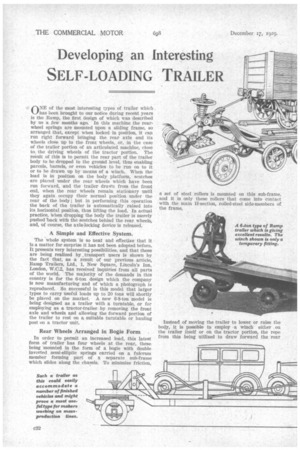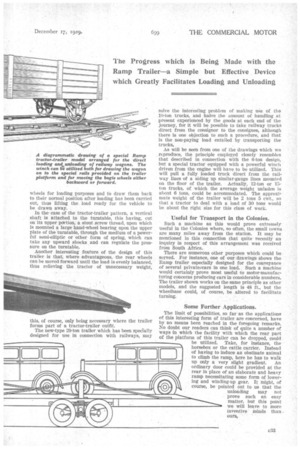Developing an Interesting SELF-LOADING TRAILER
Page 54

Page 55

If you've noticed an error in this article please click here to report it so we can fix it.
The Progress which is Being Made with the Ramp Trailer—a Simple but Effective Device which Greatly Facilitates Loading and Unloading
r't NE of the most interesting types of trailer which has been brought to our notice during recent years is the Ramp, the first design of which was described by us a few months ago. In this machine the rearwheel springs are mounted upon a sliding frame, so arranged that, except when locked in position, it cap run right forward bringing the rear axle and its wheels close up to the front wheels, or, in the case of the trailer portion of an articulated machine, close to the driving wheels of the tractor portion. The result of this is to permit the rear part of the trailer body to be dropped to the ground level, thus enabling parcels, barrels, or even vehicles to be run on to it or to he drawn up by means of a winch. When the load is in position on the body platform, scotches are placed under the rear wheels which have been run forward, and the trailer drawn from the front end, when the rear wheels remain stationary until they again occupy their normal position under the rear of the body ; but in performing this operation the back of the trailer is automatically raised into its horizontal position, thus lifting the load. In actual practice, when dropping the body the trailer is merely pushed back with the scotches behind the rear wheels, and, of course, the axle-locking device is released.
A Simple and Effective System.
The whole system is so neat and effective that it is a matter for surprise it has not been adopted before. It presents very interesting possibilities, and that these are being realized by _transport users is shown by the fact that, as a result of our previous article, Ramp Trailers, Ltd., 1, New Square, Lincoln's Inn, London, W.C.2, has received inquiries from all parts of the world. The majority of the demands in this country is for the 6-ton design which the company Is now manufacturing and of which a photograph is reproduced. So successful is this model that larger types to carry useful loads up to 20 tons will shortly be placed on the market. A new 6-8-ton model is being designed as a trailer with a turntable, or for employing as a tractor-trailer by removing the front axle and wheels and allowing the forward portion of the trailer to rest on a suitable turntable or hauling post on a tractor unit.
Rear Wheels Arranged in Bogie Form
In order to permit an increased load, this latest form of trailer has four wheels at the rear, these being mounted in the form of a bogie with double inverted semi-elliptic springs carried on a fulcrum member forming part of a separate sub-frame which slides along the chassis. To minimize friction, wheels for loading purposes and to draw them back to their normal position after loading has been carried out, thus lifting the load ready for the vehicle to be drawn away.
In the case of the tractor-trailer pattern, a vertical shaft is attached to the turntable, this having, cut on its upper portion, a stout screw thread, upon which is mounted a large hand-wheel bearing upon the upper plate of the turntable, through the medium of a powerful semi-elliptic or other form of spring, which can take any upward shocks and can regulate the pressure on the turntable.
Another interesting feature of the design of this trailer is that, where advantageous, the rear wheels can he moved forward until the load is evenly balanced, thus relieving the tractor of unnecessary weight, this, of course, only being necessary where the trailer forms part of a tractor-trailer outfit. The new-type 20-ton trailer which has been specially designed for use in connection with railways, may solve the interesting problem of making use of the 10-ton trucks, and halve the amount of handling at present experienced by the goods• at each end of the journey, for it will be possible to take railway trucks direct from the consignor to the consignee, although there is one objection to such a procedure, and that is the non-paying load entailed by transporting the trucks, As will be seen from one of the drawings which we reproduce, the principle employed closely resembles that described in connection with the 6-ton design, but a special tractor equipped with a powerful winch driven from the engine will have to be utilized. This will pull a fully loaded truck direct from the railway .lines of a siding up similar-gauge lines mounted on the floor of the trailer. Actually, 12-ton or 15ton trucks, of which the average weight unladen is about 6 tons, could be accommodated. The approxil mate weight of the trailer will be 2 tons 5 cwt., so that a tractor to deal with a load of 30 tons would be about the right size for this class of work.
Useful for Transport in the Colonies.
Such a machine as this would prove extremely useful in the Colonies where, so often, the small towns are many miles away from the station. It may be mentioned in this connection that quite recently an Inquiry in respect of this arrangement was received from South Africa.
There are numerous other purposes which could be served. For instance, one of our drawings shows the Ramp trailer especially designed for the conveyance of several privatecars in one load. Such a machine would certainly prove most useful to motor-manufacturing concerns producing cars in considerable numbers. The trailer shown works on the same principle as other models, and the suggested length is 48 ft., but the wheelbase could, of course, be altered to facilitate turning.
Some Further Applications.
The limit of possibilities, so far as the applications of this interesting form of trailer are concerned, have by no means been reached in the foregoing remarks.
No doubt our readers can think of quite a number of ways in which the facility with which the rear part of the platform of this trailer can be dropped, could be utilized. Take, for instance, the horsebox or the cattle carrier. Instead of having to induce an obstinate animal to climb the ramp, here he has to walk up only a very slight gradient. An ordinary door could be provided at the rear in place of an elaborate and heavy ramp necessitating some form of lowering and winding-up gear. It might, of course, be pointed out to us that the unloading may not prove such an easy matter, but this point we will leave to more inventive minds than ours,












































































































